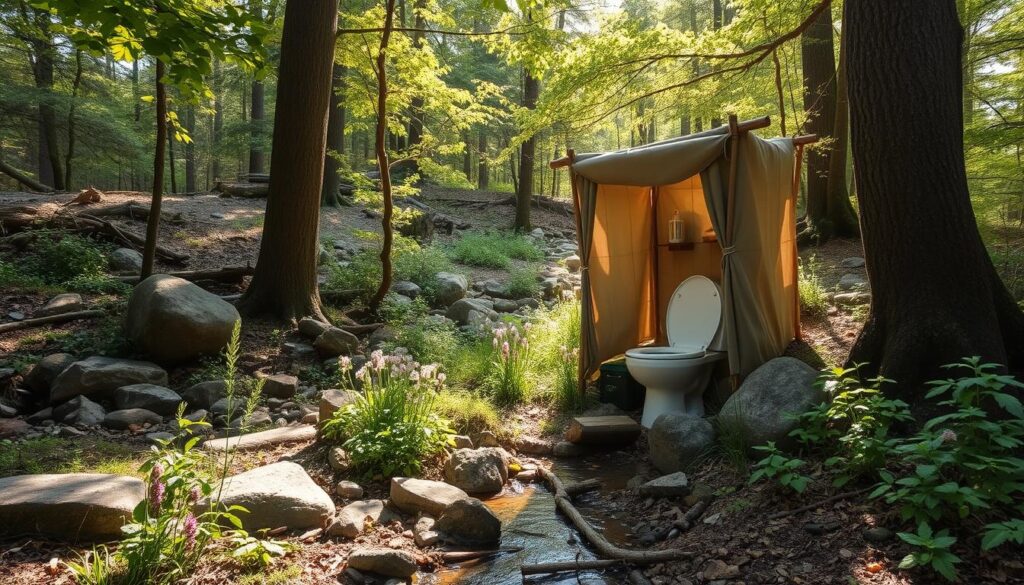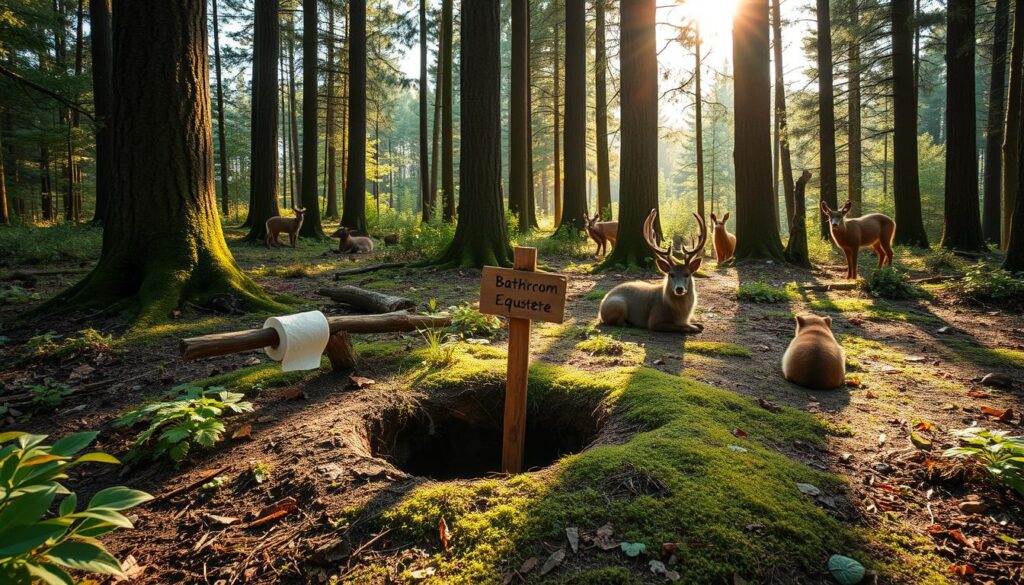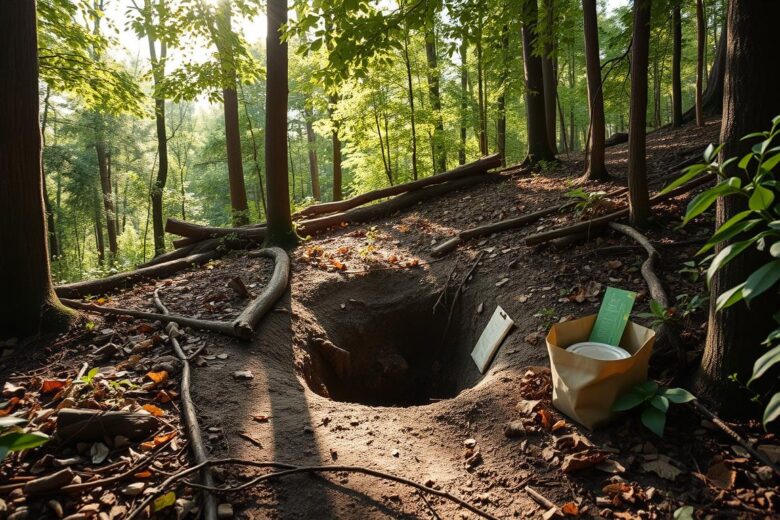Did you know that taking care of waste is key to keeping wild places beautiful? Groups like Outward Bound stress how important it is to lessen our environmental footprint. It’s vital to know how to poop outside and leave no trace. We’ll share tips and rules for doing so, helping to keep our outdoor spaces clean and safe.
Key Takeaways
- Follow Leave No Trace principles to reduce environmental impact
- Use eco-friendly pooping tips and outdoor bathroom etiquette
- Learn how to poop outdoors and leave no trace in different environments
- Understand the importance of proper waste disposal methods
- Discover creative solutions for waste management in various outdoor activities
- Learn about the benefits of using menstrual cups for sustainability during periods in the wilderness
- Monitor bowel movements as an important health indicator
Understanding the Importance of Proper Outdoor Waste Management
Managing waste outdoors is key to keeping our environment healthy and stopping disease spread. When we poop in the wild, we must do it in a way that doesn’t harm nature. This means being careful with our waste and taking steps to avoid disease.
Being mindful of how we dispose of waste is important. If we don’t, our poop can pollute water and spread sickness. To avoid this, we should dig catholes and use wag bags to carry out our waste.
Environmental Impact of Human Waste
Human waste can really hurt the environment if we don’t handle it right. It can bring in bad species and diseases, harming both nature and animals. By being careful with our bathroom habits, we can protect the environment for others to enjoy.
Health and Safety Considerations
It’s also important for our health and safety to manage waste outdoors well. If we don’t, our waste can pollute water and cause sickness. By following good waste management practices, we can keep ourselves and animals safe.
Legal Requirements in Protected Areas
In places like national parks, there are rules for handling waste. It’s important to know these rules to avoid harming the environment. By following these guidelines, we can help keep these beautiful places safe for the future.
| Location | Distance from Water Sources | Waste Disposal Method |
|---|---|---|
| Backcountry | At least 200 feet | Cathole or wag bag |
| Frontcountry | Varies by location | Restroom facilities or portable toilets |
Essential Tools and Supplies for Outdoor Bathroom Needs
When we go outdoors, it’s key to have the right tools and supplies for bathroom needs. We should use sustainable toileting in nature to protect the environment. Outward Bound shows us how to be mindful of our impact in nature.
A good outdoor bathroom kit has a trowel, toilet paper, hand sanitizer, and a backpacking bidet. Knowing waste carry-out rules for your area is also important. Some trails, like the AT, have privies, but always be ready.
- Trowel for digging catholes
- Toilet paper and a small shovel for waste disposal
- Hand sanitizer for maintaining hygiene standards
- Backpacking bidet for personal cleaning
- Opaque waste bag for containing and carrying waste out
Being prepared and using sustainable toileting in nature helps protect the environment. Always pack out used toilet paper and follow outdoor waste disposal methods for a safe environment.
Human waste can harm water sources, risking the environment and health. By using proper outdoor waste disposal methods and sustainable toileting in nature, we can keep the outdoors safe and healthy for everyone.
| Item | Importance | Usage |
|---|---|---|
| Trowel | High | Digging catholes |
| Toilet paper | Medium | Personal hygiene |
| Hand sanitizer | High | Maintaining hygiene standards |
Selecting the Perfect Spot: Location Guidelines
Choosing the right spot for an outdoor bathroom is key to keeping things clean and healthy. Responsible outdoor bathroom behavior means thinking about how our actions affect the environment and others. It’s best to pick a spot at least 200 feet away from water, camps, and trails.
When it comes to outdoor bathroom etiquette, soil and drainage are important. Different terrains filter waste differently. For example, granite and slickrock sandstone filter better than sand or forest duff. Picking the right soil helps prevent disease and keeps water clean.
Privacy is also important. Try to poop in spots where it won’t be seen by others. This keeps the area clean and respects other outdoor lovers.
- Look for spots with natural decomposition to help break down waste.
- Stay away from sensitive areas like alpine regions and desert ecosystems.
- Follow local rules and guidelines for outdoor bathroom use.
| Location | Distance from Water Sources | Soil Conditions | Privacy Considerations |
|---|---|---|---|
| Near trails and camps | At least 200 feet | Suitable for filtering contaminants | Inconspicuous spots |
| Sensitive ecosystems | Varies depending on location | Avoid areas with sensitive soil conditions | Respect local regulations and guidelines |
How to Poop Outdoors and Leave No Trace: Step-by-Step Guide
When we poop outdoors, it’s key to use eco-friendly tips to protect the environment. To leave no trace, we must think about our actions and their effects. Here’s how to do it right:
First, find a spot that’s far from trails, campsites, or water. This keeps the area clean and beautiful. Then, dig a hole that’s 4-6 inches wide and 6-8 inches deep. This helps waste break down and prevents pollution.
Here are some extra tips to remember:
- Use non-scented, single-ply toilet paper to cut down waste and harm to the environment.
- Don’t use wet wipes, as they don’t break down well and should be taken out in a Ziploc bag.
- Think about using a WAG Bag or other pack-out system, if burying waste isn’t allowed.
By following these steps and tips, we can poop outdoors without harming nature. Always choose eco-friendly options and respect the environment. This keeps public lands clean and safe for everyone.
For more eco-friendly pooping tips and outdoor advice, check out the Leave No Trace website. By working together, we can keep nature beautiful for future generations.
| Location | Distance from Water Sources | Soil Conditions |
|---|---|---|
| Trails | 200 feet | Well-draining |
| Campsites | 200 feet | Stable |
| Water Sources | 200 feet | Unstable |
Digging and Using a Cathole: Proper Techniques
When it comes to wilderness defecation practices, digging and using a cathole is key. It helps us keep the outdoors clean and healthy. First, pick a spot at least 200 feet from water, campsites, or trails.
A cathole should be 6-8 inches deep and 6 inches wide. This size helps waste break down properly. When using it, follow these steps to avoid harming the environment.
- Optimal depth and width to ensure decomposition and minimize environmental impact
- Proper covering methods to prevent attracting wildlife and contaminating water sources
- Tool sanitization to prevent the spread of diseases and maintain a clean environment
By using a cathole, we can reduce our impact on nature. Low-impact wilderness bathroom habits are important. They help keep our outdoor spaces clean and healthy.
In some places, like alpine or desert areas, you must pack out all solid waste. But in most areas, burying waste is best. By following these wilderness defecation practices and low-impact wilderness bathroom habits, we protect nature for the future.
| Location | Distance from Water Sources | Cathole Depth |
|---|---|---|
| General | 200 feet | 6-8 inches |
| Fragile Alpine or Desert | Varies | Not applicable |
Special Considerations for Different Environments
Being environmentally conscious is key when using the outdoors for bathroom activities. Each setting needs special care to keep our impact small and the area clean. For example, in deserts, we must be careful not to harm the delicate ecosystem.
In mountains, we must plan how to dispose of waste to protect water and nature. The Leave No Trace principles are vital here. They guide us to keep the outdoors clean and safe for everyone.
Some important tips for different places include:
- Avoiding sensitive habitats and wildlife areas
- Using durable surfaces for camping and traveling
- Minimizing trampling and avoiding the creation of new trails
- Properly disposing of human waste and toilet paper

By following these tips, we can enjoy the outdoors without harming it. Remember, environmentally conscious pooping and outdoor waste disposal methods are key to a sustainable future for outdoor fun.
Managing Toilet Paper and Hygiene Products
Managing toilet paper and hygiene products is key to sustainable toileting in nature. It’s often overlooked but very important. We should pack out these items to avoid harming the environment.
There are many ways to handle toilet paper and hygiene products. You can use biodegradable options or pack them out. Biodegradable items reduce waste, and packing them out ensures they’re disposed of correctly. You can also use natural items like leaves or rocks instead of toilet paper. But, it’s important to stay clean to avoid getting sick.
Here are some tips for managing these items:
- Packing out all toilet paper and hygiene products
- Using biodegradable options whenever possible
- Avoiding the use of soap or toilet paper in water sources
- Practicing good hygiene to prevent the spread of diseases
By following these tips, we can reduce our impact on nature. Sustainable toileting is a shared responsibility. Every small action helps keep our outdoor spaces beautiful.
| Best Practice | Description |
|---|---|
| Packing out toilet paper | Packing out all toilet paper and hygiene products to prevent environmental contamination |
| Using biodegradable options | Using biodegradable toilet paper and wipes to reduce waste |
| Avoiding soap in water sources | Avoiding the use of soap or toilet paper in water sources to prevent contamination |
Common Mistakes to Avoid When Pooping Outdoors
When you’re outdoors, it’s key to avoid certain mistakes. Holding it in can cause fecal impaction. Proper outdoor bathroom etiquette means finding a spot at least 200 feet from water and trails.
Another error is not digging a cathole. It should be 6-8 inches deep and 4-6 inches wide.  include using biodegradable toilet paper and packing out waste.
include using biodegradable toilet paper and packing out waste.
Other mistakes include:
- Not packing out your waste and toilet paper
- Not digging a cathole in a suitable location
- Not using biodegradable toilet paper or a portable toilet
By following these tips, you can reduce your environmental impact. This keeps the outdoors clean and enjoyable for everyone.
Don’t try to hold it. Fecal impaction is a real thing.
Always follow eco-friendly pooping tips and good outdoor bathroom etiquette. This way, you’ll have a safe and fun outdoor experience.
Conclusion: Embracing Responsible Outdoor Bathroom Practices
As we wrap up this guide on how to poop outdoors and leave no trace, it’s key to stress the need for outdoor bathroom behavior. By sticking to Leave No Trace, we can keep nature untouched. This way, we ensure the outdoors remains beautiful for future generations.
Every camper, hiker, and adventurer is vital in keeping our wild spaces clean. Small actions from many can make a big difference. This includes disposing of waste properly, taking all trash with us, and respecting the local ecosystem and indigenous heritage.
Adopting these habits helps protect the environment and keeps us safe. So, let’s all commit to embracing responsible outdoor bathroom practices and leaving no trace. Together, we can enjoy nature’s wonders while keeping it pristine for years to come.

